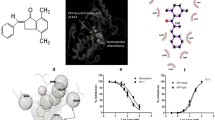Abstract
Purpose
To develop a novel anti-cancer drug of low side effect against lung adenocarcinoma, the authors screened the bioresources of Okinawa Island, Japan. The medicinal plant Toddalia asiatica Lam. contained three benzo[c]phenanthridine derivatives: dihydronitidine (DHN), nitidine (NTD) and demethylnitidine (DMN). Of the three derivatives, DHN had been shown to selectively inhibit the growth of cancer cells in our previous study. Because of similar molecular topology of NTD or DMN to DHN, it can be expected that NTD and DMN also show selective cytotoxicity. The aim of the present study was therefore to examine the selective cytotoxicity of these two compounds in vitro and in vivo.
Methods
Benzo[c]phenanthridine derivatives were isolated from T. asiatica Lam., and their chemical structures were identified by interpretation of NMR and MS spectrum. Of the isolated compounds, NTD and DMN were evaluated for cytotoxicity in vitro or in vivo.
Results
NTD as well as DHN selectively reduced the growth of murine and human lung adenocarcinoma in vitro with selective intracellular accumulation. NTD has also been proven to be highly effective in vivo to inhibit the growth of both murine and human lung adenocarcinoma in a subcutaneous xenograft model without any deteriorating side effect. In contrast, DMN had no selective cytotoxicity suggesting that 8-methoxy group of NTD is the critical structural feature for the selective cytotoxicity.
Conclusions
This study thus proves the effectiveness of benzo[c]phenanthridine derivatives as anti-cancer agent in vivo for the first time, and discusses the mechanisms responsible for the selective cytotoxicity.







Similar content being viewed by others
References
Kojima A, Hackett NR, Ohwada A, Crystal RG (1998) In vivo human carboxylesterase cDNA gene transfer to activate the prodrug CPT-11 for local treatment of solid tumors. J Clin Invest 101:1789–1796
Takimoto CH, Wright J, Arbuck SG (1998) Clinical applications of the camptothecins. Biochim Biophys Acta 1400:107–119
Kraus-Berthier L, Jan M, Guilbaud N, Naze M, Pierre A, Atassi G (2000) Histology and sensitivity to anticancer drugs of two human non-small cell lung carcinomas implanted in the pleural cavity of nude mice. Clin Cancer Res 6:297–304
Flescher E (2007) Jasmonates in cancer therapy. Cancer Lett 245:1–10
Ancuceanu RV, Istudor V (2004) Pharmacologically active natural compounds for lung cancer. Altern Med Rev 9:402–419
Iwasaki H, Oku H, Takara R, Miyahira H, Hanashiro K, Yoshida Y, Kamada Y, Toyokawa T, Takara K, Inafuku M (2006) The tumor-specific cytotoxicity of dihydronitidine from Toddalia asiatica Lam. Cancer Chemother Pharmacol 58:451–459
Li D, Zhao B, Sim SP, Li TK, Liu A, Liu LF, LaVoie EJ (2003) 8, 9-Methylenedioxybenzo[i]phenanthridines: topoisomerase I-targeting activity and cytotoxicity. Bioorg Med Chem 11:3795–3805
Affymetrix I (2002) GeneChip expression analysis technical manual. Affymetrix, Inc., Santa Clara, CA
Wang HK, Morris-Natschke SL, Lee KH (1997) Recent advances in the discovery and development of topoisomerase inhibitors as antitumor agents. Med Res Rev 17:367–425
Li D, Zhao B, Sim SP, Li TK, Liu A, Liu LF, LaVoie EJ (2003) 2, 3-Dimethoxybenzo[i]phenanthridines: topoisomerase I-targeting anticancer agents. Bioorg Med Chem 11:521–528
Makhey D, Li D, Zhao B, Sim SP, Li TK, Liu A, Liu LF, LaVoie EJ (2003) Substituted benzo[i]phenanthridines as mammalian topoisomerase-targeting agents. Bioorg Med Chem 11:1809–1820
Sanders MM, Liu AA, Li TK, Wu HY, Desai SD, Mao Y, Rubin EH, LaVoie EJ, Makhey D, Liu LF (1998) Selective cytotoxicity of topoisomerase-directed protoberberines against glioblastoma cells. Biochem Pharmacol 56:1157–1166
Makhey D, Gatto B, Yu C, Liu A, Liu LF, LaVoie EJ (1996) Coralyne and related compounds as mammalian topoisomerase I and topoisomerase II poisons. Bioorg Med Chem 4:781–791
Rothenberg ML (1997) Topoisomerase I inhibitors: review and update. Ann Oncol 8:837–855
Author information
Authors and Affiliations
Corresponding author
Rights and permissions
About this article
Cite this article
Iwasaki, H., Okabe, T., Takara, K. et al. Tumor-selective cytotoxicity of benzo[c]phenanthridine derivatives from Toddalia asiatica Lam.. Cancer Chemother Pharmacol 65, 719–726 (2010). https://doi.org/10.1007/s00280-009-1077-7
Received:
Accepted:
Published:
Issue Date:
DOI: https://doi.org/10.1007/s00280-009-1077-7




